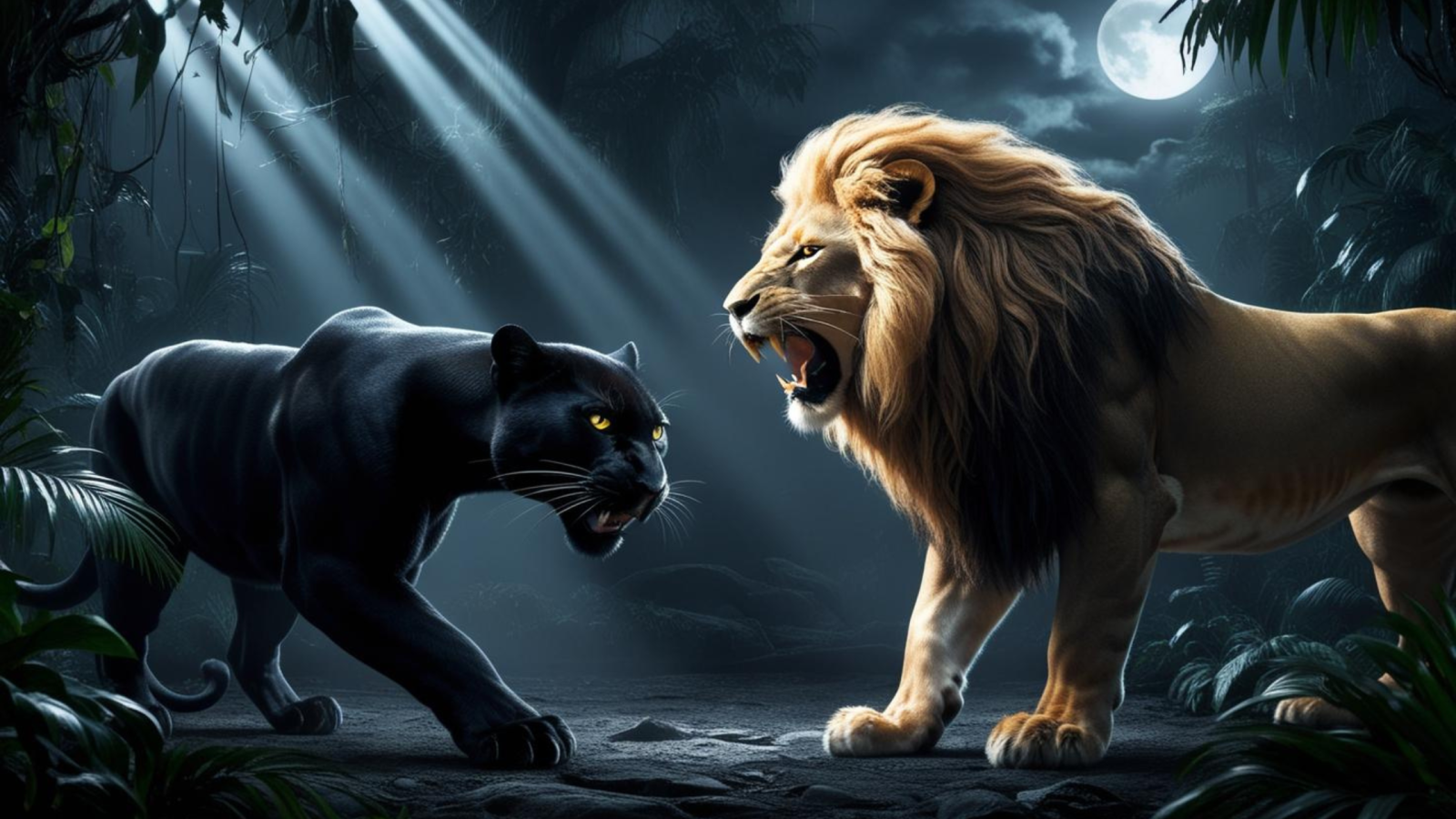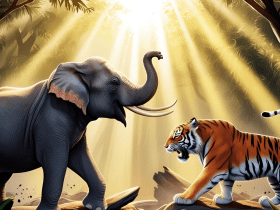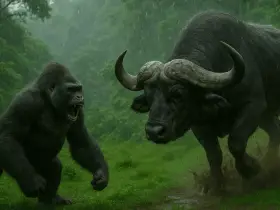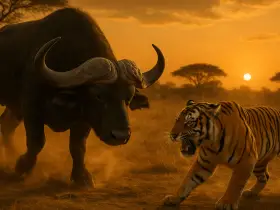Table of Contents
Toggle1. Body Specifications – Black Panther vs Lion
| Subtopic | Black Panther (Panthera pardus/Panthera onca) | Lion (Panthera leo) | Winner |
|---|---|---|---|
| Height (at shoulder) | 0.6–0.9 meters | 0.9–1.2 meters | Lion |
| Length (head to tail) | 1.8–2.5 meters | 2.4–3.3 meters | Lion |
| Weight | 36–96 kg | 120–250 kg (males), 80–160 kg (females) | Lion |
| Body Shape | Sleek, compact, agile | Robust, muscular, broad-chested | Tie |
| Bone Density | Lower bone density for agility | Higher bone density for strength | Lion |
| Muscle Mass | 50–60% of body weight | 60–70% of body weight | Lion |
| Tail Length | 0.6–1 meter | 0.6–1 meter | Tie |
| Paw Size | Smaller paws for climbing | Larger paws for gripping large prey | Lion |
| Neck Strength | Less robust neck muscles | Stronger neck muscles for subduing prey | Lion |
| Overall Size | Smaller and lighter | Larger and heavier | Lion |
2. Coat and Coloration – Black Panther vs Lion
| Subtopic | Black Panther | Lion | Winner |
|---|---|---|---|
| Base Color | Black (melanistic variant) | Tawny (golden) | Tie |
| Pattern | Rosette patterns (visible under light) | Solid color with faint spots in cubs | Black Panther |
| Melanin Levels | High melanin levels (melanism) | Normal melanin distribution | Black Panther |
| Coat Thickness | Thinner coat for warm climates | Thicker coat for varied climates | Lion |
| Coat Function | Camouflage in dense forests | Camouflage in grasslands | Tie |
| Reflectivity | High reflectivity in sunlight | Low reflectivity | Black Panther |
| Cub Coloration | Spotted (if not melanistic) | Faint spots that fade with age | Tie |
| Seasonal Changes | Minimal | Minimal | Tie |
| Unique Markings | Unique rosette patterns | Unique mane patterns in males | Tie |
| Thermoregulation | Absorbs heat in warm climates | Insulates in varied climates | Lion |
3. Habitat and Range – Black Panther vs Lion
| Subtopic | Black Panther | Lion | Winner |
|---|---|---|---|
| Geographic Range | Africa, Asia, Americas | Africa, India (Gir Forest) | Black Panther |
| Habitat Type | Rainforests, savannas, mountains | Grasslands, savannas, open woodlands | Tie |
| Adaptability | Highly adaptable to dense forests | Prefers open habitats | Black Panther |
| Climate Preference | Warm to tropical | Warm to arid | Tie |
| Territory Size | 10–50 km² | 20–400 km² | Lion |
| Elevation Range | Up to 4,500 meters | Up to 3,000 meters | Black Panther |
| Human Proximity | Can live near human settlements | Avoids human settlements | Black Panther |
| Migration Patterns | Non-migratory | Non-migratory | Tie |
| Endangered Habitats | Losing habitats to deforestation | Losing habitats to human encroachment | Tie |
| Range Overlap | Overlaps with lions in some regions | Overlaps with black panthers in some regions | Tie |
4. Diet and Hunting
| Subtopic | Black Panther | Lion | Winner |
|---|---|---|---|
| Prey Type | Medium-sized mammals (monkeys, antelope) | Large ungulates (zebras, wildebeests) | Lion |
| Hunting Success Rate | 20–30% | 25–30% | Tie |
| Daily Caloric Intake | 1,500–3,000 kcal | 5,000–7,000 kcal | Lion |
| Hunting Techniques | Stealth and climbing | Cooperative hunting | Lion |
| Prey Size | Up to 100 kg | Up to 500 kg | Lion |
| Scavenging Behavior | Occasionally scavenges | Frequently scavenges | Lion |
| Hunting Time | Nocturnal | Crepuscular and nocturnal | Tie |
| Kill Frequency | 1–2 kills per week | 1 large kill every 3–4 days | Lion |
| Food Storage | Rarely caches prey | Does not cache prey | Tie |
| Competition | Competes with tigers and lions | Competes with hyenas and leopards | Tie |
5. Strength and Bite Force – Black Panther vs Lion
| Subtopic | Black Panther | Lion | Winner |
|---|---|---|---|
| Bite Force (PSI) | 600–700 PSI | 650 PSI | Tie |
| Claw Strength | Retractable, sharp claws | Retractable, sharp claws | Tie |
| Lifting Capacity | Can lift 1.5x body weight | Can lift 2x body weight | Lion |
| Jaw Muscles | Strong but less powerful | Powerful jaw muscles | Lion |
| Neck Bite Precision | Targets throat | Targets spine and throat | Lion |
| Limb Strength | Stronger hind limbs | Stronger forelimbs | Tie |
| Bone Crushing Ability | Can crush smaller bones | Can crush large bones | Lion |
| Swatting Force | Can swat with 5,000 lbs of force | Can swat with 10,000 lbs of force | Lion |
| Grip Strength | Strong grip for climbing | Stronger grip for large prey | Lion |
| Overall Strength | Strong but less powerful | Stronger in all aspects | Lion |
6. Speed and Agility – Black Panther vs Lion
| Subtopic | Black Panther | Lion | Winner |
|---|---|---|---|
| Top Speed | 58–60 km/h | 80 km/h | Lion |
| Acceleration | 0–60 km/h in 3 seconds | 0–60 km/h in 4 seconds | Black Panther |
| Agility in Trees | Extremely agile in trees | Cannot climb trees | Black Panther |
| Swimming Ability | Good swimmer | Moderate swimmer | Black Panther |
| Stamina | Moderate stamina | High stamina for short bursts | Lion |
| Jumping Height | Can jump 3 meters vertically | Can jump 2 meters vertically | Black Panther |
| Jumping Distance | Can jump 6 meters horizontally | Can jump 12 meters horizontally | Lion |
| Climbing Speed | Faster climber | Cannot climb | Black Panther |
| Maneuverability | Highly maneuverable | Less maneuverable | Black Panther |
| Overall Agility | Highly agile | Strong but less agile | Black Panther |
7. Senses – Black Panther vs Lion
| Subtopic | Black Panther | Lion | Winner |
|---|---|---|---|
| Vision Acuity | Superior night vision | Excellent night vision | Black Panther |
| Hearing Range | Can hear up to 65 kHz | Can hear up to 60 kHz | Black Panther |
| Olfactory Capabilities | Stronger sense of smell | Strong sense of smell | Black Panther |
| Depth Perception | Excellent | Excellent | Tie |
| Color Vision | Limited color vision | Limited color vision | Tie |
| Motion Detection | Highly sensitive | Highly sensitive | Tie |
| Low Light Vision | Superior | Excellent | Black Panther |
| Sensory Whiskers | Highly sensitive | Highly sensitive | Tie |
| Auditory Localization | More precise | Precise | Black Panther |
| Overall Senses | Stronger senses | Strong senses | Black Panther |
8. Reproduction and Lifespan
| Subtopic | Black Panther | Lion | Winner |
|---|---|---|---|
| Gestation Period | 90–105 days | 100–110 days | Tie |
| Litter Size | 2–3 cubs | 2–4 cubs | Lion |
| Cub Mortality Rate | 40–50% | 50–60% | Black Panther |
| Sexual Maturity Age | 2–3 years | 3–4 years | Black Panther |
| Lifespan (Wild) | 12–15 years | 10–14 years | Black Panther |
| Lifespan (Captivity) | 20–23 years | 20–25 years | Tie |
| Parental Care | Mother raises cubs alone | Pride raises cubs together | Lion |
| Weaning Age | 3–4 months | 6–8 months | Black Panther |
| Interbirth Interval | 1–2 years | 2–3 years | Black Panther |
| Reproductive Success | Higher due to adaptability | Lower due to pride dynamics | Black Panther |
9. Social Behavior
| Subtopic | Black Panther | Lion | Winner |
|---|---|---|---|
| Social Structure | Solitary | Social (prides) | Lion |
| Territorial Range | 10–50 km² | 20–400 km² | Lion |
| Communication Methods | Growls, hisses, scent marking | Roars, growls, scent marking | Lion |
| Aggression Levels | Less aggressive | Highly aggressive | Lion |
| Mating Behavior | Polygamous | Polygamous | Tie |
| Cub Interaction | Mother-cub bond only | Pride raises cubs together | Lion |
| Territorial Marking | Scent marking and scratching | Scent marking and roaring | Lion |
| Conflict Resolution | Avoidance and posturing | Physical fights | Black Panther |
| Group Hunting | Rarely | Frequently | Lion |
| Overall Sociability | Less social | Highly social | Lion |
10. Conservation Status
| Subtopic | Black Panther | Lion | Winner |
|---|---|---|---|
| IUCN Status | Vulnerable (leopard/jaguar) | Vulnerable | Tie |
| Population Trends | Stable/Declining (varies by region) | Declining | Black Panther |
| Threats | Poaching, habitat loss | Poaching, habitat loss, human-wildlife conflict | Tie |
| Conservation Efforts | Protected areas, anti-poaching | Strict anti-poaching laws | Tie |
| Wild Population | ~500,000 (leopards/jaguars) | ~20,000 | Black Panther |
| Captive Population | ~10,000 individuals | ~1,000 individuals | Black Panther |
| Genetic Diversity | Higher due to larger populations | Lower due to fragmented populations | Black Panther |
| Reintroduction Success | Moderate success | Limited success | Black Panther |
| Public Awareness | Moderate | High | Lion |
| Future Outlook | Stable but concerning | Critical | Black Panther |
Read More – Elephant vs Rhino who will win : A Comprehensive Comparison
References
- IUCN Red List: www.iucnredlist.org
- National Geographic: www.nationalgeographic.com
- Smithsonian’s National Zoo: nationalzoo.si.edu
- Journal of Mammalogy: academic.oup.com
- Wildlife Conservation Society: www.wcs.org






Leave a Reply